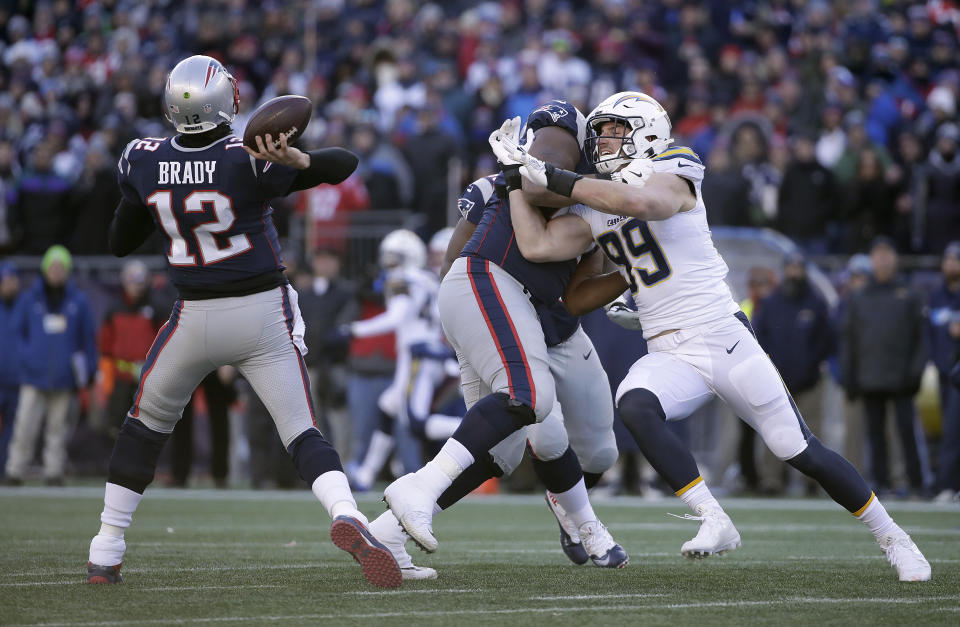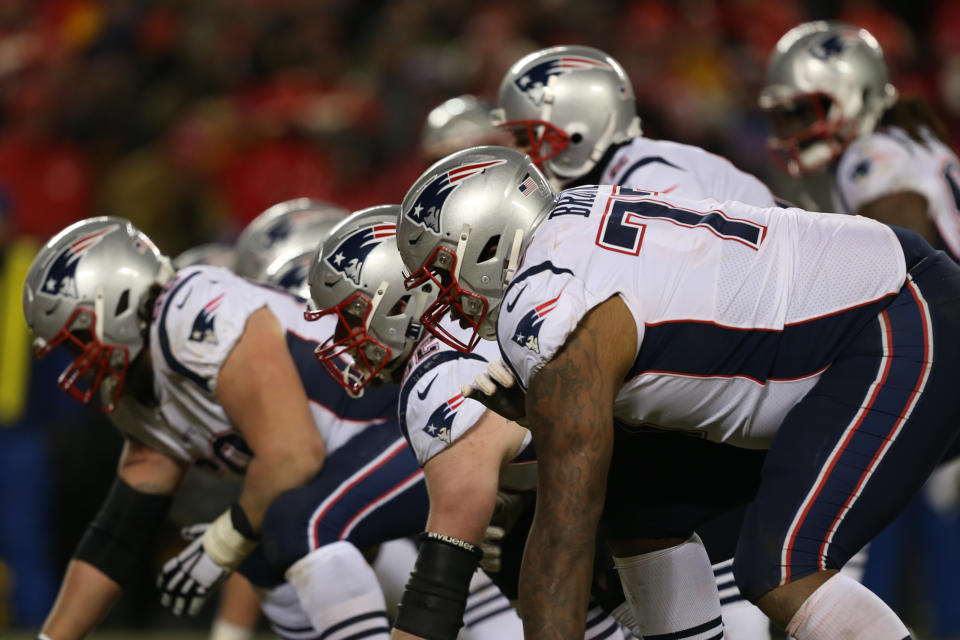Tom Brady's wall of protection includes incredible bargains that explain part of Patriots' dominance
Last March, the New York Giants lured Nate Solder away from New England by making him the NFL’s highest-paid offensive lineman.
A little over five weeks later the Patriots found what turned out to be his replacement this season by trading a third-round pick to San Francisco in exchange for a fifth-rounder and a guy named Trent Brown, who finished 2017 on the injured-reserve list due a bad shoulder.
Solder’s four-year deal with the Giants could average as much as $15.5 million a year.
Brown’s salary this season is $1.9 million.

This was part of Bill Belichick’s plan to protect the NFL’s most important asset – the blind side of his 41-year-old quarterback, Tom Brady – while trying to win another Super Bowl, which at this point in Foxborough is the one and only goal.
If you want to know why the Patriots keep making the Super Bowl – Sunday’s against the Los Angeles Rams will be their third consecutive, fourth in five seasons and ninth overall under Belichick – well, this is as good an example as any.
In a manner that runs against all known conventional wisdom, Belichick didn’t just rebuild a vital unit. He somehow managed to improve it.
With Solder gone and right tackle Marcus Cannon’s future in doubt due to an ankle injury that caused him to miss much of 2017, the NFL Network’s Charley Casserly called the position group “a mess.” It was reasonable analysis.
Belichick tried to address it by drafting Isaiah Wynn out of Georgia with the 23rd overall pick in the 2018 NFL draft. Wynn, however, blew his Achilles in August and was lost for the season. Things looked grim.
Despite that, the Patriots’ offensive line went from liability to strength, ranking first in the league during the regular season in adjusted sack rate, which factors in not just sacks allowed, but down, distance and opponent, per Football Outsiders. They were third in adjusted line yards, which considers the role of the offensive line in each rushing yard gained.
They’ve been even better in the playoffs.
Brady hasn’t been sacked, has been hit just once and seen pressure on just 15.8 percent of his 90 pass attempts despite facing feared rushers Joey Bosa and Melvin Ingram of the Chargers and Dee Ford and Chris Jones of the Chiefs.
Meanwhile the Patriots have rushed 82 times for 331 yards and eight touchdowns, and dominated the time of possession by an almost 2-to-1 margin.
They’ve done it all with Brown, a former seventh-round pick, holding one edge. Cannon, a former fifth-rounder and cancer survivor, has returned to form to handle the other.
In the interior there is right guard Shaq Mason, a fourth-round pick from Georgia Tech. Left guard Joe Thuney was a third-rounder out of North Carolina State, who played every offensive snap in 2018 and will become the first player in NFL history to start in the Super Bowl in each of his first three seasons.
Finally, there is center David Andrews, who was drafted by no one in 2015. Belichick signed him as an unrestricted free agent. He has started 57 games since.

There are no high picks. No free-agent pursuits. Only Brown isn’t homegrown. The entire group could be considered a steal.
The Patriots’ salary-cap expenditure for their entire offensive line – including backups LaAdrian Waddle, Ted Karras and James Ferentz – is just $17.3 million, ranking 26th in the league, per Spotrac.com.
The Dallas Cowboys’ Tyron Smith cost $17.6 million by himself. He’s really good, but still.
While no one thing will win the Super Bowl, if New England’s offensive line can neutralize the Rams’ ferocious defensive line, as it did to the Chargers and Chiefs, then Belichick will feel pretty good about his chances.
If nothing else, the group has created such a sense of security that Brady isn’t just still healthy, but declaring he will return for the 2019 season, at age 42.
Some of the credit goes to legendary, 70-year-old position coach Dante Scarnecchia. Some goes to having the additional blocking of tight end Rob Gronkowski, who may do it better than anyone at his position.
Yet some of it is finding the right people for the right spots at the right times. The drafting of Cannon, Thuney and Mason, and signing of Andrews through the years were brilliant individual selections. The trade for Brown was the topper and speaks to how Belichick builds a roster.
While Wynn was the original plan to fill Solder’s position, Belichick wasn’t afraid to use the draft to acquire a current player who intrigued him … and perhaps only him.
If the 49ers thought Brown could have been a Super Bowl starting-caliber left tackle, they wouldn’t have traded him. If anyone else saw it, his draft value would have been higher.
Instead Belichick got him in exchange for dropping 48 spots in the middle of the 2018 draft. (The 49ers moved up to draft a defensive back, Tarvarius Moore, who spent much of the season on the scout team. The Pats dropped back and got a linebacker, Ja’Whaun Bentley, who started immediately and looked promising until an injury ended his season.)
What Belichick saw in Brown was a physical and massive player (6-foot-8, 380 pounds), yet with quick, light feet under him. The potential was there.
“He’s a very unique player,” Belichick said earlier this season. “His size is rare. His athleticism is good, but when you combine it with his size, that’s rare too. You don’t see guys that big playing over there. He’s very gifted.”
He fits in with the rest of the line. Belichick marveled the other day about how during team conditioning sessions the offensive line holds its own against fleeter of foot position groups. That’s the mentality of the group. Cannon, the eight-year vet, says the cohesiveness is everything – “the offensive line is together.” And some of that is because no one is in position to take a single snap, or perhaps even a practice wind sprint, for granted.
Everyone still sees themselves as overlooked and underrated players trying to hang on in the NFL. Cannon, for one, beat non-Hodgkin lymphoma early in his career and then battled back from an ankle injury that almost sat him for good.
It’s why, after a late Rex Burkhead touchdown run during the AFC title game, Cannon eschewed celebrating with his teammates to stand at the 4-yard line and spend five or six seconds alone quietly staring up into the sky, lost in another improbable moment.
“I was just thanking God,” Cannon said afterward. “I’ve had a lot of struggles and wasn’t sure what to do. He told me to trust him and he led me here.”
Now he’s back in the Super Bowl, with a unit that’s better, and perhaps more important to the game plan, than ever.
Run the ball. Control the clock. Give Brady time. Limit Aaron Donald and Ndamukong Suh.
It seems daunting, unless you never should have been here in the first place.
Subscribe to The Yahoo Sports NFL Podcast
Apple Podcasts• Stitcher • Google Podcasts
More from Yahoo Sports:
• Djokovic blows past Nadal to win record seventh Australian Open
• Warriors hold off Celtics in potential NBA Finals preview
• Iole: Emelianenko’s legacy secure despite one-sided KO vs. Bader
• Sunday marks 19-year anniversary of Patriots hiring Belichick as head coach


